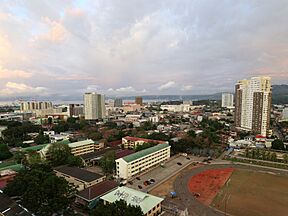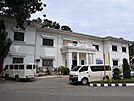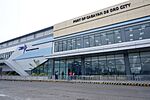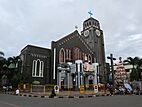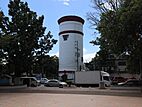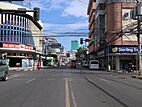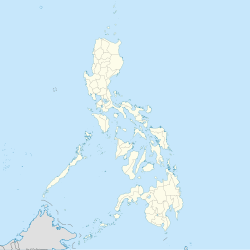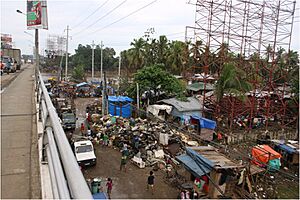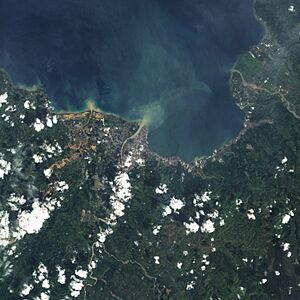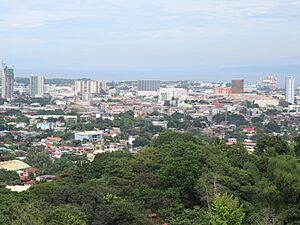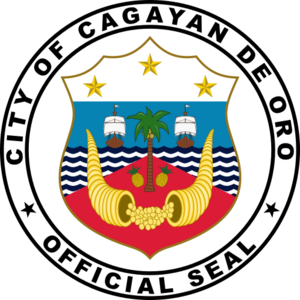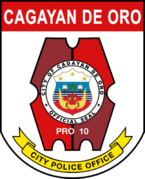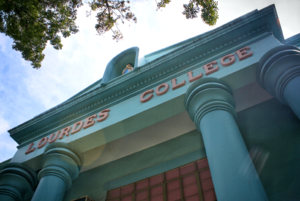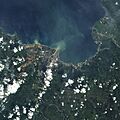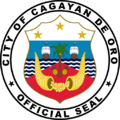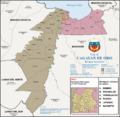Cagayan de Oro facts for kids
Quick facts for kids
Cagayan de Oro
|
|||
|---|---|---|---|
|
Highly urbanized city
|
|||
|
Skyline
City Hall
Port of Cagayan de Oro
Gaston Park
Saint Augustine Cathedral
Cagayan de Oro City Museum
A. Velez Street corner J. R. Borja Avenue
|
|||
|
|||
| Etymology: Cagayan de Misamis | |||
Nicknames:
|
|||
| Anthem: "Cagayan de Oro March" | |||

Map of Northern Mindanao with Cagayan de Oro highlighted
|
|||
|
OpenStreetMap
|
|||
| Country | Philippines | ||
| Region | Northern Mindanao | ||
| Province | Misamis Oriental (geographically only) | ||
| District | 1st and 2nd districts | ||
| Settlement re-established | 1626 | ||
| Town | 1871 | ||
| Cityhood | June 15, 1950 | ||
| Highly urbanized city | November 22, 1983 | ||
| Barangays | 80 (see Barangays) | ||
| Government
|
|||
| • Type | Sangguniang Panlungsod | ||
| Area | |||
| • City | 412.80 km2 (159.38 sq mi) | ||
| Elevation | 428 m (1,404 ft) | ||
| Highest elevation | 2,892 m (9,488 ft) | ||
| Lowest elevation | 0 m (0 ft) | ||
| Population
(2020 census)
|
|||
| • City | 728,402 | ||
| • Rank | 10th | ||
| • Density | 1,764.540/km2 (4,570.14/sq mi) | ||
| • Metro | 1,687,159 | ||
| • Households | 190,225 | ||
| Demonym(s) | Cagayanons; Kagay-anons | ||
| Economy | |||
| • Gross domestic product | ₱261.7 billion (2022) $4.62 billion (2022) |
||
| • Income class | 1st city income class | ||
| • Poverty incidence |
|
||
| • Revenue | ₱ 5,564 million (2022) | ||
| • Assets | ₱ 13,608 million (2022) | ||
| • Expenditure | ₱ 4,503 million (2022) | ||
| • Liabilities | ₱ 5,727 million (2022) | ||
| Service provider | |||
| • Electricity | Cagayan Electric Power and Light Company (CEPALCO) | ||
| • Water | Cagayan de Oro Water District (COWD) | ||
| • Cable TV | Parasat Cable TV | ||
| Time zone | UTC+08:00 (PST) | ||
| ZIP code |
9000
|
||
| PSGC |
[https://psa.gov.ph/classification/psgc/?q=psgc/barangays/{{#pro000®code={{&provcode=
|
||
| IDD : area code | +63 (0)88 | ||
| Native languages | Cebuano, Tagalog | ||
| Abbreviations | CdeO, CDO, CDOC, Cag. de Oro | ||
| Feast date | August 28 | ||
| Patron saint | Augustine of Hippo | ||
| Website | cagayandeoro |
||
Cagayan de Oro (often called CDO) is a big city in the Northern Mindanao region of the Philippines. It is known as the "City of Golden Friendship" and the "Whitewater Rafting Capital of the Philippines." In 2020, about 728,402 people lived there, making it the 10th most populated city in the country.
Cagayan de Oro is the main city and business center of Northern Mindanao. It is part of a larger area called Metro Cagayan de Oro. The city is located on the north central coast of Mindanao island, facing Macajalar Bay. It is famous for exciting white water rafting and kayaking on the Cagayan de Oro River.
Contents
- What Does the Name Cagayan de Oro Mean?
- A Look at Cagayan de Oro's Past
- Where is Cagayan de Oro Located?
- Who Lives in Cagayan de Oro?
- How Does Cagayan de Oro Make Money?
- How is Cagayan de Oro Governed?
- Getting Around Cagayan de Oro
- Public Services in the City
- Staying Safe in Cagayan de Oro
- Healthcare in Cagayan de Oro
- Learning in Cagayan de Oro
- Fun Things to Do in Cagayan de Oro
- Images for kids
- See also
What Does the Name Cagayan de Oro Mean?
The name Cagayan de Oro means "River of Gold." It comes from the Spanish language. When Spanish missionaries arrived in 1622, the area was already called "Cagayán." This word, and others like karayan or kagayan, all mean river.
Later, a former Vice President of the Philippines, Emmanuel Peláez, added "de Oro" to the name. This made it "Cagayan de Oro." There are other places in the Philippines with "Cagayan" in their name, like a province in northern Luzon.
A Look at Cagayan de Oro's Past
How Old is Cagayan de Oro?
People have lived in the Cagayan de Oro area for a very long time. The oldest human remains found are from the Huluga Caves. These remains are from around 350 to 377 AD. The caves were used as a burial place by early people.
Many old items have been found in the caves. The nearby Huluga Open Site is thought to be where the first settlement, "Himologan," was located. This site is about eight kilometers from today's city.
Ancient Trade and Early Settlements
In 2009, a grave site was found with pottery from China (Song dynasty) and Thailand (Sukhothai period). This shows that the area was part of an old trading network in Southeast Asia. Skulls found also show that early Kagay-anons shaped their heads as a sign of social status.
The Huluga Open Site was partly damaged in 2001 for a bridge project. Local historians and archaeologists have tried to protect it. They believe it is an important historical site.
Spanish Influence and Changes
When the Spanish arrived in 1622, the Himologan settlement was still active. The people living there were a mix of local Lumad and sea-faring Visayans. They were described as having tattoos and wearing fancy jewelry.
In 1626, a Spanish friar named Agustín de San Pedro convinced the chief, Datu Salangsang, to move the settlement. They moved it closer to the Cagayan River, where Gaston Park is today. This new settlement was made stronger to protect against attacks.
By 1738, Spain had a strong presence in Cagayan de Oro. In 1871, it became a town and the capital of Misamis province. It was known as Cagayan de Misamis. In 1883, it became an important Spanish government center for parts of Mindanao.
American Period and Local Resistance

After Spain gave the Philippines to the United States in 1898, many people in Cagayan de Misamis were against it. They fought against the Americans during the Philippine–American War. American forces arrived on March 31, 1900.
Local fighters, led by Gen. Nicolas Capistrano, attacked the American soldiers but were pushed back. On June 4, 1900, Filipino soldiers won a battle at Makahambus Hill. This was the first time Americans were defeated in the war.
After the war, Cagayan de Oro grew into a busy trade center. Many people from other parts of the Philippines moved there. The Philippines gained independence from the United States on July 4, 1946.
World War II and Japanese Occupation
On May 3, 1942, Japanese forces invaded Cagayan de Oro. American and Filipino soldiers fought bravely but had to retreat. The Japanese burned much of the city. They used Ateneo de Cagayan University as their base.
Filipino and American guerrilla fighters resisted the Japanese throughout the occupation. American planes bombed the university and a church in October 1944. The Japanese could not control areas outside the city for long.
Combined American and Filipino forces landed in Cagayan de Oro on May 10, 1945. This was three years and seven days after the Japanese took over. The city was finally freed.
Becoming a City: Postwar Era
In 1949, local leaders worked to make Cagayan de Misamis a city. On June 15, 1950, President Elpidio Quirino signed a law making it the chartered city of Cagayan de Oro. Emmanuel Pelaez, a congressman, helped make this happen.
Maximo Y. Suniel was the last mayor of Cagayan de Misamis and the first mayor of the new city. In 1983, Cagayan de Oro was declared a highly urbanized city. This meant it was independent from the provincial government.
Recent Challenges: Tropical Storms
On December 16–17, 2011, Tropical Storm Sendong caused terrible floods in Northern Mindanao. In Cagayan de Oro, many people living near the Cagayan de Oro River lost their lives. Hundreds were also missing.
The storm brought heavy rain for 10 hours, causing rivers to overflow. Many victims were sleeping when the floods hit. This disaster led people to move away from the riverbanks to higher areas in the city.
In January 2017, heavy rains caused more flooding. Many streets were underwater, and students at the University of Science and Technology of Southern Philippines were trapped. Shopping malls were also badly flooded.
On December 21, 2017, Typhoon Vinta hit Mindanao. Three bridges in Cagayan de Oro were closed because of rising water. Thousands of people had to move to higher ground or evacuation centers.
Where is Cagayan de Oro Located?
Cagayan de Oro is on the north central coast of Mindanao island. It faces Macajalar Bay, which connects to the Bohol Sea. The city is bordered by different towns and provinces.
- To the south, it borders Bubong, Lanao del Sur.
- To the west, it borders Rogongon, a part of Iligan City, Lanao del Norte.
- To the east, it is next to the towns of Manolo Fortich, Libona, Baungon, and Talakag in Bukidnon.
- It also borders Tagoloan to the east and Opol to the west.
The city covers about 488.86 square kilometers. This is about 13.9% of the entire Misamis Oriental province. A large part of the city is agricultural land (44.7%), and 38.4% is open spaces.
City Districts and Barangays
Cagayan de Oro is divided into 80 areas called barangays. Each barangay has smaller parts called puroks or sitios.
The city has two main districts:
- The 1st District is west of the Cagayan River and has 24 barangays. These are mostly suburban areas.
- The 2nd District is east of the river and has 56 barangays. This includes the city proper, with barangays numbered 1 to 40.
| Barangay | Location | Classification | District | Population |
|---|---|---|---|---|
| Barangay 1 | East | Urban | Second District | 168 |
| Barangay 2 | East | Urban | Second District | 50 |
| Barangay 3 | East | Urban | Second District | 93 |
| Barangay 4 | East | Urban | Second District | 68 |
| Barangay 5 | East | Urban | Second District | 34 |
| Barangay 6 | East | Urban | Second District | 33 |
| Barangay 7 | East | Urban | Second District | 544 |
| Barangay 8 | East | Urban | Second District | 90 |
| Barangay 9 | East | Urban | Second District | 130 |
| Barangay 10 | East | Urban | Second District | 557 |
| Barangay 11 | East | Urban | Second District | 162 |
| Barangay 12 | East | Urban | Second District | 257 |
| Barangay 13 | East | Urban | Second District | 965 |
| Barangay 14 | East | Urban | Second District | 351 |
| Barangay 15 | East | Urban | Second District | 1847 |
| Barangay 16 | East | Urban | Second District | 25 |
| Barangay 17 | East | Urban | Second District | 2058 |
| Barangay 18 | East | Urban | Second District | 1269 |
| Barangay 19 | East | Urban | Second District | 227 |
| Barangay 20 | East | Urban | Second District | 80 |
| Barangay 21 | East | Urban | Second District | 363 |
| Barangay 22 | East | Urban | Second District | 3324 |
| Barangay 23 | East | Urban | Second District | 936 |
| Barangay 24 | East | Urban | Second District | 607 |
| Barangay 25 | East | Urban | Second District | 661 |
| Barangay 26 | East | Urban | Second District | 1215 |
| Barangay 27 | East | Urban | Second District | 1601 |
| Barangay 28 | East | Urban | Second District | 493 |
| Barangay 29 | East | Urban | Second District | 476 |
| Barangay 30 | East | Urban | Second District | 678 |
| Barangay 31 | East | Urban | Second District | 575 |
| Barangay 32 | East | Urban | Second District | 792 |
| Barangay 33 | East | Urban | Second District | 84 |
| Barangay 34 | East | Urban | Second District | 529 |
| Barangay 35 | East | Urban | Second District | 2002 |
| Barangay 36 | East | Urban | Second District | 447 |
| Barangay 37 | East | Urban | Second District | 181 |
| Barangay 38 | East | Urban | Second District | 48 |
| Barangay 39 | East | Urban | Second District | 17 |
| Barangay 40 | East | Urban | Second District | 339 |
| Agusan | East | Urban | Second District | 19039 |
| Balubal | East | Urban | Second District | 7013 |
| Bugo | East | Urban | Second District | 31229 |
| Camaman-an | East | Urban | Second District | 35238 |
| Consolacion | East | Urban | Second District | 9396 |
| Cugman | East | Urban | Second District | 23468 |
| F. S. Catanico | East | Urban | Second District | 2364 |
| Gusa | East | Urban | Second District | 28974 |
| Indahag | East | Urban | Second District | 17831 |
| Lapasan | East | Urban | Second District | 39234 |
| Macabalan | East | Urban | Second District | 19562 |
| Macasandig | East | Urban | Second District | 23235 |
| Nazareth | East | Urban | Second District | 6971 |
| Puerto | East | Urban | Second District | 13174 |
| Puntod | East | Urban | Second District | 18775 |
| Tablon | East | Urban | Second District | 23578 |
| Baikingon | West | Urban | First District | 2879 |
| Balulang | West | Urban | First District | 42205 |
| Bayabas | West | Urban | First District | 13991 |
| Bayanga | West | Urban | First District | 3402 |
| Besigan | West | Urban | First District | 1700 |
| Bonbon | West | Urban | First District | 10976 |
| Bulua | West | Urban | First District | 35397 |
| Canito-an | West | Urban | First District | 34250 |
| Carmen | West | Urban | First District | 77756 |
| Dansolihon | West | Urban | First District | 6206 |
| Iponan | West | Urban | First District | 27521 |
| Kauswagan | West | Urban | First District | 40239 |
| Lumbia | West | Urban | First District | 31504 |
| Mambuaya | West | Urban | First District | 5963 |
| Pagalungan | West | Urban | First District | 2410 |
| Pagatpat | West | Urban | First District | 13007 |
| Patag | West | Urban | First District | 17941 |
| Pigsag-an | West | Urban | First District | 1428 |
| San Simon | West | Urban | First District | 1642 |
| Taglimao | West | Urban | First District | 1391 |
| Tagpangi | West | Urban | First District | 2823 |
| Tignapoloan | West | Urban | First District | 5621 |
| Tuburan | West | Urban | First District | 1388 |
| Tumpagon | West | Urban | First District | 2305 |
What is the Climate Like?
Cagayan de Oro has a tropical monsoon climate. This means it is generally hot and humid. The average temperature is about 28°C (82°F). The hottest temperature recorded was 39°C (102°F) in June 1998.
The city does not get the same amount of rain all year. March and April are the driest months. August and September are the wettest. The rainy season is from June to November. The drier season is from December to May. The city is usually safe from typhoons.
| Climate data for Cagayan de Oro (Lumbia Airport) 1991–2020, extremes 1979–2020 | |||||||||||||
|---|---|---|---|---|---|---|---|---|---|---|---|---|---|
| Month | Jan | Feb | Mar | Apr | May | Jun | Jul | Aug | Sep | Oct | Nov | Dec | Year |
| Record high °C (°F) | 36.2 (97.2) |
36.0 (96.8) |
37.6 (99.7) |
37.0 (98.6) |
38.2 (100.8) |
38.4 (101.1) |
36.2 (97.2) |
37.8 (100.0) |
36.7 (98.1) |
35.2 (95.4) |
34.7 (94.5) |
34.4 (93.9) |
38.4 (101.1) |
| Mean daily maximum °C (°F) | 29.8 (85.6) |
30.3 (86.5) |
31.4 (88.5) |
32.6 (90.7) |
33.0 (91.4) |
32.1 (89.8) |
31.7 (89.1) |
32.2 (90.0) |
32.1 (89.8) |
31.5 (88.7) |
31.1 (88.0) |
30.4 (86.7) |
31.5 (88.7) |
| Daily mean °C (°F) | 25.8 (78.4) |
26.0 (78.8) |
26.7 (80.1) |
27.6 (81.7) |
28.1 (82.6) |
27.5 (81.5) |
27.2 (81.0) |
27.4 (81.3) |
27.3 (81.1) |
27.0 (80.6) |
26.7 (80.1) |
26.3 (79.3) |
27.0 (80.6) |
| Mean daily minimum °C (°F) | 21.7 (71.1) |
21.6 (70.9) |
21.9 (71.4) |
22.7 (72.9) |
23.3 (73.9) |
22.9 (73.2) |
22.6 (72.7) |
22.6 (72.7) |
22.5 (72.5) |
22.4 (72.3) |
22.2 (72.0) |
22.1 (71.8) |
22.4 (72.3) |
| Record low °C (°F) | 16.1 (61.0) |
17.1 (62.8) |
17.1 (62.8) |
18.0 (64.4) |
20.7 (69.3) |
20.0 (68.0) |
20.0 (68.0) |
19.4 (66.9) |
19.0 (66.2) |
19.0 (66.2) |
18.0 (64.4) |
17.8 (64.0) |
16.1 (61.0) |
| Average rainfall mm (inches) | 97.6 (3.84) |
85.3 (3.36) |
57.6 (2.27) |
62.1 (2.44) |
128.9 (5.07) |
220.1 (8.67) |
247.3 (9.74) |
197.4 (7.77) |
220.8 (8.69) |
191.6 (7.54) |
127.1 (5.00) |
137.5 (5.41) |
1,773.3 (69.81) |
| Average rainy days (≥ 0.1 mm) | 10 | 8 | 6 | 6 | 11 | 16 | 17 | 14 | 15 | 14 | 10 | 9 | 136 |
| Average relative humidity (%) | 85 | 84 | 81 | 79 | 80 | 83 | 84 | 82 | 83 | 84 | 84 | 85 | 83 |
| Source: PAGASA | |||||||||||||
Who Lives in Cagayan de Oro?
In 2020, Cagayan de Oro had 728,402 people. This makes it the 10th largest city in the Philippines. Many people in Cagayan de Oro are a mix of different ethnic groups.
About 22% of the people are Cebuano, and 4% are Boholano. Other groups include indigenous people like Higaonon and Manobo. There are also Muslim groups like Maranaos and Maguindanaons. People from Luzon, like Tagalogs and Ilocanos, also live here.
What Languages are Spoken?
Most people in Cagayan de Oro speak Cebuano. Tagalog is also widely used. English is common for business and in schools.
The city's Muslim community often speaks Maranao. Other languages like Subanen, Binukid, and Hiligaynon are also spoken by different groups.
What Religions are Practiced?
Most people in Cagayan de Oro are Roman Catholic, making up almost 70% of the population. The city is home to the Archdiocese of Cagayan de Oro. The main church is the Saint Augustine Metropolitan Cathedral.
- Black Nazarene Shrine: In 2009, a copy of the famous Black Nazarene statue was brought to Cagayan de Oro. This allows people in Mindanao to visit it without traveling to Manila. The city hosts a large annual procession for the Black Nazarene.
- Protestant Christianity: Many Protestant churches have grown in the city. These include Pentecostal, Adventist, and Methodist churches.
- Islam: Many Muslim people live in Cagayan de Oro, especially those from nearby Iligan and Marawi. There are several mosques in the city. The oldest is Masjid Oro Jammah, founded in 1930. Masjid Sharif Alawi is the largest mosque in Northern Mindanao.
- Other Religions: Some Chinese residents practice Buddhism and Taoism. Indian residents may practice Sikhism or Hinduism.
How Does Cagayan de Oro Make Money?
Cagayan de Oro is a major business center in Northern Mindanao. Its economy relies on industry, commerce, trade, services, and tourism. The city has seen a lot of investment in malls, hotels, and convention centers.
In 2014, the United Nations called Cagayan de Oro an "emerging city of tomorrow." This was because of its strong economy. In 2018, the city was named the "Top 5 Most Competitive City" in the Philippines.
Big Companies and Local Businesses
Many large companies have operations in Cagayan de Oro. These include Del Monte, Nestle, and Oishi. The city also has many local businesses.
Banking and Shopping
Cagayan de Oro is an important financial center. It has a branch of the Bangko Sentral ng Pilipinas (Central Bank). As of December 2019, there were over 140 banks in the city.
The city has many shopping malls, like Limketkai Center. These malls have various stores and supermarkets.
Business Process Outsourcing (BPO)
The BPO industry is growing in Cagayan de Oro. This is because the city has many skilled workers. New buildings are being built for call centers and other BPO companies.
How is Cagayan de Oro Governed?
Cagayan de Oro is led by a mayor-council government. The mayor, vice mayor, and city council members are elected for three-year terms. The city also has two representatives in the House of Representatives.
The current city officials are:
- House of Representatives
- 1st Legislative district: Rep. Lordan G. Suan
- 2nd Legislative district: Rep. Rufus B. Rodriguez
- Mayor: Rolando A. Uy
- Vice Mayor: Jocelyn B. Rodriguez
Getting Around Cagayan de Oro

Cagayan de Oro is a gateway to Northern Mindanao. You can reach it by land, air, or water. Inside the city, you can use taxis, jeepneys, or motorelas. Trisikads (pedicabs) are good for short distances. Vans can take you to places outside the city, like the airport.
Ports for Shipping and Travel
The Port of Cagayan de Oro in Macabalan is a very busy port. It is one of the largest international and domestic seaports in Mindanao. It handles many goods and connects the city to other major cities like Manila and Cebu.
Other companies like General Milling and Del Monte Philippines also have their own port facilities. The Mindanao International Container Port is nearby in Tagoloan.
Laguindingan Airport
Cagayan de Oro's main airport is Laguindingan Airport (CGY). It handles flights to and from Manila, Cebu, Iloilo, and Davao. The airport opened on June 15, 2013. It is about 46 kilometers northwest of Cagayan de Oro.
You can get to the airport by yellow taxis, regular taxis, or shuttle vans. Several companies offer shuttle services from different points in the city.
Bus Terminals
The city has two main bus terminals:
- The Eastbound Integrated Bus Terminal (Agora) serves trips to eastern parts of Mindanao. This includes places like Butuan and Davao City.
- The Westbound Integrated Bus and Jeepney Terminal serves trips to western parts of Mindanao. This includes Iligan, Ozamiz, and Zamboanga City.
Public Services in the City
Water and Electricity
Water services are provided by the Cagayan de Oro Water District (COWD). It was the first water district in the Philippines. The city's water comes from the Cagayan de Oro River.
Electricity is mainly supplied by Cagayan Electric Power and Light Company (CEPALCO). CEPALCO covers most of Cagayan de Oro and nearby towns. It gets power from various sources, including coal, diesel, and hydro plants. CEPALCO also operates a large solar power plant in Barangay Indahag.
Communication Services
Telephone and internet services are provided by companies like PLDT, Philcom, Globe, Smart, and Sun.
Staying Safe in Cagayan de Oro
Cagayan de Oro is an important base for the Philippine Air Force, Philippine Army, and Philippine National Police. Lumbia Airport is used as an air base.
The Philippine Army has a large military camp in Barangay Patag. This camp is home to the 4th infantry division. The Philippine National Police (PNP) has its regional headquarters at Camp Alagar. The PNP and Army work together to keep the city safe.
In 2017, Cagayan de Oro improved its emergency services. You can now dial 911 for immediate help from the city's emergency response team.
Healthcare in Cagayan de Oro
Cagayan de Oro has many hospitals. There are three government-run hospitals: Justiniano R. Borja General Hospital, Camp Evangelista Station Hospital, and Northern Mindanao Medical Center.
There are also several private hospitals, such as Capitol University Medical City and Maria Reyna–Xavier University Hospital. The city also has a special facility for drug abuse treatment. Many hospitals have been expanded and modernized.
Learning in Cagayan de Oro
Cagayan de Oro has many schools and universities. There are five main private universities: Xavier University – Ateneo de Cagayan, Capitol University, Liceo de Cagayan University, Lourdes College, and Cagayan de Oro College. The University of Science and Technology of Southern Philippines is the city's only state university.
Other schools include Southern Philippines College and Pilgrim Christian College. There are also foreign schools and Chinese schools like Kong Hua School.
Fun Things to Do in Cagayan de Oro
Festivals and Celebrations
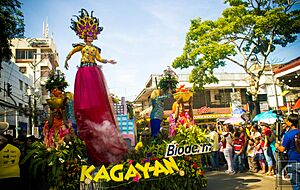
Cagayan de Oro has many exciting events and festivals. Each barangay has its own Fiesta to honor its patron saint.
- Higalaay Festival: This is a week-long celebration in August. It honors the city's patron saint, St. Augustine. Highlights include trade fairs, beauty pageants, street dancing, and culinary shows.
- Pasko de Oro: This festival takes place in December along the Rio de Oro Boulevard. It features dragon boat racing, street dancing, and a fluvial (river) religious procession.
- Feast of the Black Nazarene: Held every January 9, this religious event includes a large procession called "Traslacion." Cagayan de Oro is one of only three cities in the Philippines to host this event.
- Himugso: This celebration marks Cagayan de Oro's Charter Day (June 15, 1950) and Philippine Independence Day (June 12, 1898).
Arts and Culture Venues
RODELSA Hall, run by Liceo de Cagayan University, is a place for performing arts. It hosts concerts and film screenings. The Xavier Center for Culture and the Arts (XCCA) also supports various cultural programs.
The city is also known for the Kadaiyahan festival, which celebrates diversity and supports LGBTQ+ rights.
What to Eat in Cagayan de Oro?
Cagayan de Oro has a mix of local and international foods. The city is famous for its pastel bread, chicharrón, and Hamon de Cagayan. You can also find many street foods like kwek-kwek and fish balls.
The city has many restaurants, fast-food places, and coffee shops. You can find Chinese and Korean cuisines, along with local Filipino dishes.
Sports and Recreation
Cagayan de Oro has basketball teams like the Cagayan de Oro Stars. It is also known for its old lawn tennis clubs. White water rafting and kayaking events are held annually on the Cagayan River.
The city is a strong center for chess. Sports venues include the Pelaez Memorial Sports Center, which is one of the biggest in Mindanao. Cagayan de Oro also has go-kart tracks, including the first electric go-kart facility in Mindanao. The Pueblo de Oro Golf and Country Club is the city's only championship golf course.
Images for kids
-
American forces attacking Makahambus, around 1900s.
-
Sayre Highway in upland Barangay Puerto connecting the city to the province of Bukidnon
-
During the Higalaay (Kagay-an Festival) 2014
See also
- List of renamed cities and municipalities in the Philippines
- List of tallest buildings in Cagayan de Oro


